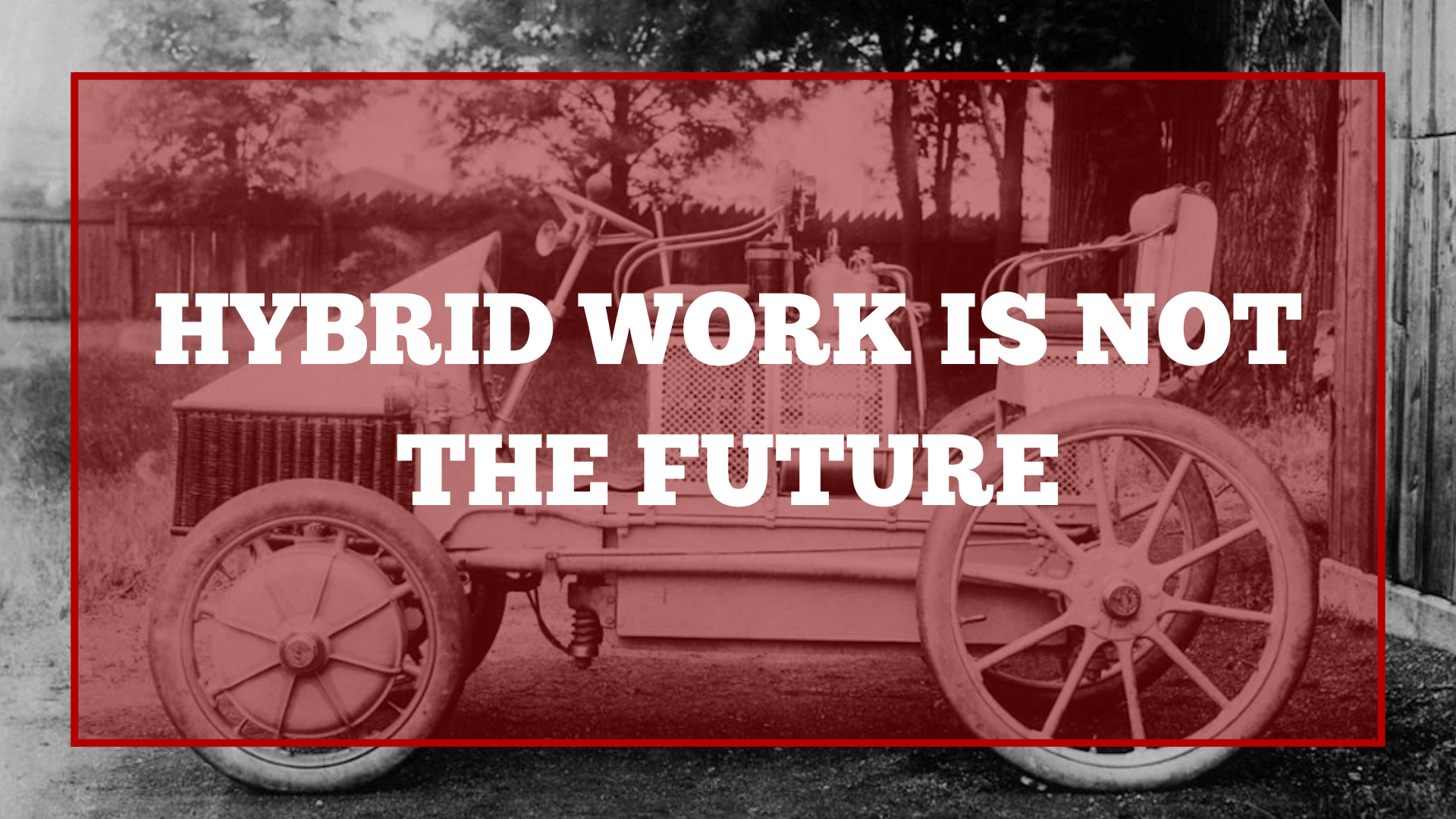No, Hybrid Work Is Not The Future.
The media has declared that the future of work is hybrid.
(Just so we’re all on the same page, this is how I’d define hybrid work: The company plans to have employees working from home part of the time and in an office part of the time. That’s from our workplace dictionary).
This argument for hybrid work comes off as lazy.
The basic premise seems to be that we all have these offices from 2019 and we all worked from home in 2020, so let’s just combine the two and call it the future of work. Put another way, we all have office leases to fill but everyone wants to work from home.
There are three reasons hybrid work has no future
Incentive structures run the world. As Charlie Munger, billionaire investor and right-hand man to Warren Buffett, said, “Show me the incentive and I’ll show you the outcome.”
The incentives force hybrid companies to choose fully remote or fully in-person operating systems over time. Here’s why and how all these companies will switch to remote-first within a few years.
See Also: Every Fortune 100’s Return To Office Policy
1. The hybrid work model is the hardest on internal communication, forcing the company toward fully remote or fully in-person.
When all of your people work from home, communication channels are digital. You have no choice. It’s easy to decide where conversations happen.
When all of your people work in an office together, all meetings happen in person. Side chats can take place at desks. It’s easy to decide where conversations happen.
When some people are at home and some are in the office, it’s harder to pick the right communication channels to fit everyone’s needs.
- Where do meetings take place, in person or on Zoom?
- Where are quick, impromptu decisions made, in the hallway or on Slack?
- If everyone is in the office for a big meeting except one person, should we set up a Zoom call just for that person or not invite them at all?
As a result of this confusion, companies will define either a remote-first communication model or office-first communication model.
If they choose to be a remote-first company, they need the office less and less and it therefore becomes a liability rather than an asset. Each new hire, more likely than not, would be remote pushing the team toward fully remote over time. Then, the office goes away. There is no hybrid left.
If they choose to be an office-first company, they’d encourage more visits to the office from remote employees. Each new job posting would be for an in-person position replacing one remote position with an in-person one step-by-step. The leadership team would build into their culture the importance of in-person collaboration. There is no hybrid left.
The incentive to pick clear communication channels will force the company away from hybrid. Points two and three below show why they’ll choose remote first.
2. The talent pool is greatly reduced by a physical location, forcing many more fully remote new hires.
Let’s assume a company announces a new hybrid remote work policy because it anticipates 50% of its people will be in the office at any given time.
How will things progress from there?
For example, let’s say the sales team needs to hire five new people. They post the jobs as hybrid positions–in the office a few days a week and at home a few. But, that requires the person to live locally, within a 50-mile radius. They get a just a handful of applicants because the talent pool is limited geographically.
They decide to change the job posting to remote or hybrid, the candidate can choose. The company figures it already supports this sort of structure for remote work, why not expand it a bit?
With that posting, they receive tons of applicants and make four of the five hires as fully remote because the talent pool was the whole country (or world).
The company is now more remote than hybrid.
Each new job posting after that will have the remote option in order attract better talent.
The incentive to hire around the country or world will overtake the desire to run a hybrid model. The company will become “remote-first” within a few years.
See Also: 16 Benefits of Working From Home (For Employers)
3. The company will pay for an office it doesn’t need, pushing the balance toward fully remote work.
Now, the company has the majority of it’s people operating in fully-remote positions. The people left using the office are the minority.
Every meeting will have more remote people than office people, forcing the meetings to be held online. In-office employees are essentially working remotely from within the office.
Ultimately, the leadership team holds a meeting (on Zoom, all from their living rooms) to answer the question, “Do we really need this office?”
- Most of our team is remote because that’s how we could find talent
- We’re about to make this big decision over Zoom, maybe in-person collaboration is overrated
- Oh by the way, the office is our second biggest expense…
The incentive to cut the cost of office space will overtake what’s left of the idea of hybrid work. The company will become “remote-first” forever.
You won’t hear much about hybrid work in five years
Let’s go back to the beginning. What I think is really happening here is that we’re transitioning from primarily in-office work to primarily remote work. But, companies still have long leases on their office spaces. Some people are excited to get back to the office, even if they are in the minority. And since most people are based near the office, let’s just say we’re now hybrid.
The problem is that hybrid does not last as a long-term, viable option.
First, the communication channels turn remote.
Then, the workforce turns remote.
Finally, the office space goes away.
And all of the companies that announced hybrid models in 2020-2021 will announce remote-first models by 2025.
See Also: 54 Future Of Work Predictions For 2030
If you would like to learn more about hybrid work (despite reading my argument above), here is our complete guide to the hybrid work trend.
Hybrid Work Model: The Complete Overview
|

